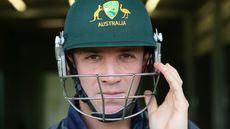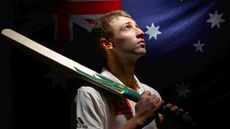Why did Phillip Hughes die? 'Freak injury' caused tragedy
Batsman was struck in the neck by bouncer, in an area helmets 'cannot protect'

The shocking death of Australian cricketer Phillip Hughes, two days after he was struck by a bouncer during a Sheffield Shield match in Sydney, has raised questions about the safety of players.
The sequence of events leading up to the tragic moment when he suffered "catastrophic" injuries was unremarkable. Hughes, whose job as a top-order batsman was to see off fast bowling, was well set at the crease. He was also wearing a helmet when he was hit by a routine bouncer delivered by young fast bowler Sean Abbott.
So why did he die?
Subscribe to The Week
Escape your echo chamber. Get the facts behind the news, plus analysis from multiple perspectives.

Sign up for The Week's Free Newsletters
From our morning news briefing to a weekly Good News Newsletter, get the best of The Week delivered directly to your inbox.
From our morning news briefing to a weekly Good News Newsletter, get the best of The Week delivered directly to your inbox.
The helmet
Much has been made of the fact that Hughes was wearing an old-style helmet, manufactured by Masuri, when he was struck in an unprotected area behind the grille and below the shell.
"The model Hughes was wearing does not offer as much protection to the back of the head and neck as newer models issued by Masuri," the company acknowledged, according to The Independent.
But it is unclear if the new designs would have prevented the ball from hitting Hughes as he was struck in a "vulnerable area of the head and neck that helmets cannot fully protect, while enabling batsmen to have full and proper movement", said Masuri.
The introduction of helmets in the 1970s and 80s made batting much less dangerous, but they are not a guarantee of safety. Last summer Stuart Broad had his nose broken by a ball that flew between the peak and grill of his helmet and it is not uncommon to see batsmen floored by bouncers.
The shot
Never one to mince his words, Geoffrey Boycott, writing for the Daily Telegraph before news of Hughes's death emerged, said that modern players took too many risks when facing short balls.
"Helmets have unfortunately now taken away a lot of that fear and have given every batsman a false sense of security," he wrote. "They feel safe and people will now attempt to either pull or hook almost every short ball that is bowled at them."
Hughes was attempting a pull shot when he was hit.
The 'freakish accident'
The medical reason for Hughes's death emerged at an emotional press conference on Thursday. The ball from Abbott hit Hughes on the neck rather than the head, causing an artery carrying blood to the brain to split. It was, said Cricket Australia doctor Peter Brukner, a "freakish accident" and one from which there is little chance of recovery.
"The injury, called a subarachnoid haemorrhage, occurs when an artery is compressed and splits, forcing blood into the brain area. Only one case had previously been reported as a result of a cricket ball," reports the Telegraph.
"It was an injury to the neck that caused haemorrhage in the brain," explained Brukner. "The condition is incredibly rare."
Such "catastrophic" injuries are often fatal at the time, he added. Hughes lost consciousness almost immediately after being hit and had to be resuscitated on the field, but was in "reasonable condition" when he was taken to hospital.
After being rushed to St Vincent's Hospital in Sydney, Hughes underwent surgery and part of his skull was removed to relieve pressure on his brain. However, the injury proved too severe and two days later he died.
Create an account with the same email registered to your subscription to unlock access.
Sign up for Today's Best Articles in your inbox
A free daily email with the biggest news stories of the day – and the best features from TheWeek.com
-
 5 ways to help the environment while on vacation
5 ways to help the environment while on vacationThe Week Recommends An afternoon of planting trees could be the best part of your trip
By Catherine Garcia, The Week US Published
-
 Doctors are taking on dental duties in low-income areas
Doctors are taking on dental duties in low-income areasUnder the radar Physicians are biting into the dentistry industry
By Devika Rao, The Week US Published
-
 Instagram hopes that blurring nudity in messages will make teens safer
Instagram hopes that blurring nudity in messages will make teens saferThe Explainer The option will be turned on by default for users under 18
By Justin Klawans, The Week US Published
-
 Phillip Hughes death an accident, but sledging must stop, says inquest
Phillip Hughes death an accident, but sledging must stop, says inquestSpeed Read Australian coroner rules cricketer was killed after making a 'miniscule misjudgement' and no one was to blame
By The Week Staff Last updated
-
 Surrey cricketers 'doing well' in hospital after 'sickening' clash
Surrey cricketers 'doing well' in hospital after 'sickening' clashIn Depth Moises Henriques suffers broken jaw in collision with Rory Burns, as crowd fears the worst after Phillip Hughes
By The Week Staff Published
-
 2014: the sporting year in pictures
2014: the sporting year in picturesSpeed Read From Robin van Persie to Mo Farah, a collection of the best images from the year in sport
By The Week Staff Published
-
 Michael Clarke leads tributes to Phillip Hughes at funeral
Michael Clarke leads tributes to Phillip Hughes at funeralIn Depth Australian skipper breaks down as nation comes to a standstill for service
By The Week Staff Published
-
 Cricket pays tribute to Phillip Hughes with #putoutyourbats
Cricket pays tribute to Phillip Hughes with #putoutyourbatsIn Depth Twitter unites to remember Australian star as fans and players post images of their bats
By The Week Staff Published
-
 Cricketer Phil Hughes dies from 'catastrophic' bouncer injury
Cricketer Phil Hughes dies from 'catastrophic' bouncer injurySpeed Read Australian international never regained consciousness after being struck on the neck by a short ball
By Bill Mann Published
-
 Phil Hughes: Australian cricketer 'critical' after being hit by ball
Phil Hughes: Australian cricketer 'critical' after being hit by ballSpeed Read The outcome of surgery on 25-year-old Phil Hughes will not be known for 24 hours, authorities say
By The Week Staff Published